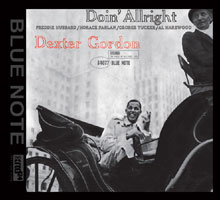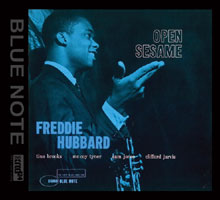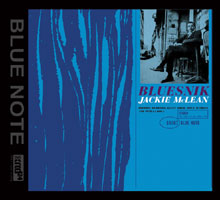Dexter Gordon • Doin' Allright
Freddie Hubbard • Open Sesame
Jackie McLean • Bluesnik
he years 1960 and 1961 were pivotal for the music industry. Rock'n'roll was ascending, and whether the labels knew it or not, all other musical forms were on their way down in popularity -- jazz foremost among them. Yet those two years yielded a treasure trove of important jazz recordings. The three titles here are all superb examples of where jazz was at that time, and they are tied together by the presence of trumpeter Freddie Hubbard, all of 22 when the first of these recordings was made. On Open Sesame, Hubbard shows how well he could play both driving hard bop and contemplative ballads. His slow, soulful work on the standard "But Beautiful" is a rousing example of the latter, while his efforts on the two Tina Brooks-penned tunes -- the title track and "Gypsy Blue" -- show how well he played off the athletic tenor work of the unjustly neglected Brooks. Open Sesame also demonstrates Hubbard’s emerging compositional abilities with "Hub’s Nub." On Bluesnik, Jackie McLean was beginning to adapt to the free-jazz stylings of Ornette Coleman, and Hubbard proves he is equally at home. He could handle a mixture of hard bop and free jazz with the skill of an older and more experienced musician. Finally, on Dexter Gordon’s Doin' Allright, Hubbard shows he wasn’t just paying attention to what was going on around him. He had learned where the jazz of the day had come from. Gordon’s mixture of styles -- from swing to bebop to hard bop -- was challenging, and Hubbard was equal to the task. All three of these recordings offer state-of-the-art digital sound. The use of the XRCD24 process takes them to the very heights of Red Book CD's capabilities. The drums have snap, the cymbals shimmer, and the bass deep and woody resonance. The piano, not engineer Rudy Van Gelder’s strong point, displays realistic percussion -- the hammer-hitting-the-string sound of the real thing. The horns have both brassy bite and, in the case of the saxophones, a reedy quality. There is enough space and detail to satisfy even the most persnickety listeners. If you love Blue Note jazz but not the sound of Blue
Note's RVG CD reissues (you're not alone), these discs -- along with all of the others in
Audio Wave's growing series -- will let you realize everything that Blue Note had to offer
musically and sonically. |



